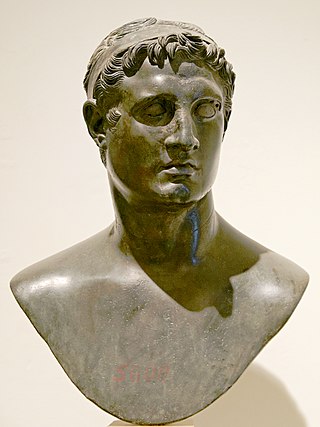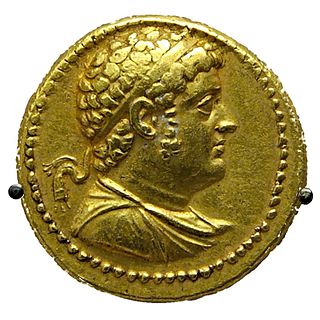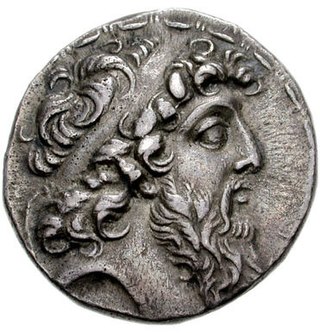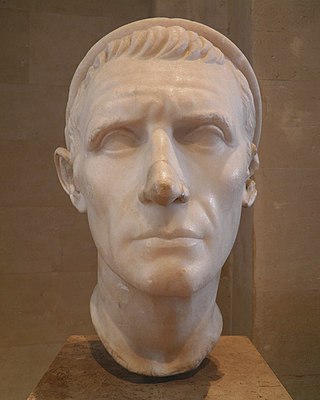Related Research Articles

The Seleucid Empire was a Hellenistic kingdom in West Asia during the Hellenistic period. It was founded in 312 BC by the Macedonian general Seleucus I Nicator, following the division of the Macedonian Empire founded by Alexander the Great, and ruled by the Seleucid dynasty until its annexation by the Roman Republic under Pompey in 63 BC.
This article concerns the period 169 BC – 160 BC.

Ptolemy III Euergetes was the third pharaoh of the Ptolemaic dynasty in Egypt from 246 to 222 BC. The Ptolemaic Kingdom reached the height of its military and economic power during his kingship, as initiated by his father Ptolemy II Philadelphus.

Ptolemy II Philadelphus was the pharaoh of Ptolemaic Egypt from 284 to 246 BC. He was the son of Ptolemy I, the Macedonian Greek general of Alexander the Great who founded the Ptolemaic Kingdom after the death of Alexander, and Queen Berenice I, originally from Macedon in northern Greece.

Ptolemy IV Philopator was the fourth pharaoh of Ptolemaic Egypt from 221 to 204 BC.

Demetrius II, called Nicator, was one of the sons of Demetrius I Soter. His mother may have been Laodice V, as was the case with his brother Antiochus VII Sidetes. Demetrius ruled the Seleucid Empire for two periods, separated by a number of years of captivity in Hyrcania in Parthia, first from September 145 BC to July/August 138 BC, and again from 129 BC until his death in 125 BC. His brother Antiochus VII ruled the Seleucid Empire in the interim between his two reigns.

Antiochus III the Great was a Greek Hellenistic king and the 6th ruler of the Seleucid Empire, reigning from 223 to 187 BC. He ruled over the region of Syria and large parts of the rest of western Asia towards the end of the 3rd century BC. Rising to the throne at the age of eighteen in April/June 223 BC, his early campaigns against the Ptolemaic Kingdom were unsuccessful, but in the following years Antiochus gained several military victories and substantially expanded the empire's territory. His traditional designation, the Great, reflects an epithet he assumed. He also assumed the title Basileus Megas, the traditional title of the Persian kings. A militarily active ruler, Antiochus restored much of the territory of the Seleucid Empire, before suffering a serious setback, towards the end of his reign, in his war against Rome.

Antiochus IV Epiphanes was a Greek Hellenistic king who ruled the Seleucid Empire from 175 BC until his death in 164 BC. He was a son of King Antiochus III the Great. Originally named Mithradates, he assumed the name Antiochus after he ascended the throne. Notable events during Antiochus's reign include his near-conquest of Ptolemaic Egypt, his persecution of the Jews of Judea and Samaria, and the rebellion of the Jewish Maccabees.

The Maccabees, also spelled Machabees, were a group of Jewish rebel warriors who took control of Judea, which at the time was part of the Seleucid Empire. They founded the Hasmonean dynasty, which ruled from 167 BCE to 37 BCE, being a fully independent kingdom from about 110 to 63 BCE. They reasserted the Jewish religion, expanded the boundaries of Judea by conquest, and reduced the influence of Hellenism and Hellenistic Judaism.

The Hasmonean dynasty was a ruling dynasty of Judea and surrounding regions during the Hellenistic times of the Second Temple period, from c. 140 BCE to 37 BCE. Between c. 140 and c. 116 BCE the dynasty ruled Judea semi-autonomously in the Seleucid Empire, and from roughly 110 BCE, with the empire disintegrating, Judea gained further autonomy and expanded into the neighboring regions of Perea, Samaria, Idumea, Galilee, and Iturea. The Hasmonean rulers took the Greek title basileus ("king") as the kingdom became a regional power for several decades. Forces of the Roman Republic intervened in the Hasmonean Civil War in 63 BCE and made it into a client state, marking the decline of Hasmonean dynasty; Herod the Great displaced the last reigning Hasmonean client-ruler in 37 BCE.
2 Maccabees, also known as the Second Book of Maccabees, Second Maccabees, and abbreviated as 2 Macc., is a deuterocanonical book which recounts the persecution of Jews under King Antiochus IV Epiphanes and the Maccabean Revolt against him. It concludes with the defeat of the Seleucid Empire general Nicanor in 161 BC by Judas Maccabeus, the leader of the Maccabees.
3 Maccabees, also called the Third Book of Maccabees, is a book written in Koine Greek, likely in the 1st century BC in either the late Ptolemaic period of Egypt or in early Roman Egypt. Despite the title, the book has nothing to do with the Maccabean Revolt against the Seleucid Empire described in 1 Maccabees and 2 Maccabees. Instead it tells the story of a persecution of the Jews under Pharaoh Ptolemy IV Philopator in Ptolemaic Egypt, some decades before the Maccabee uprising in Judea. The story purports to explain the origin of a Purim-like festival celebrated in Egypt. 3 Maccabees is somewhat similar to the Book of Esther, another book which describes how a king is advised to annihilate the Diaspora Jews in his territory, yet is thwarted by God.

The Acra, with the meaning of "stronghold", was a place in Jerusalem thought to have had a fortified compound built by Antiochus Epiphanes, ruler of the Seleucid Empire, following his sack of the city in 168 BCE. The name Acra was also used at a later time for a city quarter probably associated with the by-then destroyed fortress, known in his time to Josephus as both Acra and "the lower city". The fortress played a significant role in the events surrounding the Maccabean Revolt, which resulted in the formation of the Hasmonean Kingdom. The "upper city" was captured by Judas Maccabeus, with the Seleucid garrison taking refuge in the "Acra" below, and the task of destroying this last enemy stronghold inside Jerusalem fell to Simon Maccabeus surnamed Thassi. Our knowledge about the Acra is based almost exclusively on the writings of Josephus, which are of a later date, and on the First and Second Books of Maccabees, which were written not long after the described events.
Jason was the High Priest of Israel from around 175 BCE to 171 BCE during the Second Temple period of Judaism. He was of the Oniad family and was brother to Onias III, his predecessor as High Priest. Josephus records that his name was originally Jesus or Joshua before he changed it.
Acra or ACRA may refer to:

The Maccabean Revolt was a Jewish rebellion led by the Maccabees against the Seleucid Empire and against Hellenistic influence on Jewish life. The main phase of the revolt lasted from 167–160 BCE and ended with the Seleucids in control of Judea, but conflict between the Maccabees, Hellenized Jews, and the Seleucids continued until 134 BCE, with the Maccabees eventually attaining independence.

Jerusalem during the Second Temple period describes the history of Jerusalem during the Second Temple period, from the return to Zion under Cyrus the Great to the siege and destruction the city by Titus during the First Jewish–Roman War. During this period, which saw the region and city change hands several times, Jerusalem was the center of religious life for all Jews; even those who lived in the diaspora prayed towards Jerusalem on a daily basis and made pilgrimages during religious festivals. Under Hasmonean and Herodian rule, Jerusalem served as a royal capital and the seat of all major national institutions. In Jerusalem, the Pharisees of Second Temple Judaism developed into the Tannaim and Judaism's post-Exilic religious identity as it continues today, and the Hebrew Bible was perhaps canonized, although exactly when this occurred remains disputed. It was also in Jerusalem during the later stages of this period that Christianity was born.

The Hasmonean Baris was a citadel constructed north of Jerusalem's Temple Mount in existence during the Hasmonean period.

The Struthion Pool, effectually translated from the Greek as 'Sparrow Pool' is a large cuboid cistern beneath the Convent of the Sisters of Zion in the Old City of Jerusalem, built by Herod the Great in the first century BCE.
Hellenistic Palestine, or Hellenistic Judea, is the term for the history of the region of Palestine or Judea–Samaria during the Hellenistic period, when Achaemenid Syria was conquered by Alexander the Great and subsumed into his growing Macedonian empire. Following his death and the division of his empire among the Diadochi, the region came first under Ptolemaic rule beginning in the late 4th century BCE with Ptolemy I Soter, followed by Seleucid rule beginning in the early 2nd century BCE with Antiochus III the Great. Later the same century, the Maccabean revolt weakened the grip of the Seleucid Empire and paved the way for the emergence of the rule of the local Hasmonean dynasty. Following the 63 BCE Siege of Jerusalem by Pompey the Great, the region was annexed by the Roman Republic, marking the end of Hellenistic Palestine and the beginning of Roman Judea.
References
- ↑ Carter, C. E. 1999. The Emergence of Yehud in the Persian Period. Sheffield Academic Press.
- ↑ Wightman G. J. 1991. Temple Fortresses in Jerusalem Part II: The Hasmonean Baris and Herodian Antonia. Bulletin of the Anglo-Israeli Archaeological Society 10, pp. 7–35.
- ↑ Josephus, Jewish Antiquities XII: 133, 138.
- ↑ Grabbe, L. L. 2008. A History of the Jews and Judaism in the Second Temple Period. Volume 2 – The Coming of the Greeks: The Early Hellenistic Period (335 – 175 BCE). T & T Clark, London.
- ↑ The Letter of Aristeas, 100–104. Translation by R. H. Charles
- ↑ Avi-Yonah, M. The Walls of Nahemiah – a Minimalist View. Israel Exploration Journal IV, pp. 239 – 248.
- ↑ Honigman S. 2003. The Septuagint and Homeric Scholarship in Alexandria, pp. 128 – 130. Routledge, London.
- ↑ Bar-Kochva. 1989. Judas Maccabeus, pp. 445–465. Cambridge
- ↑ Dequeker L. 1985. The City of David and the Seleucid Acra in Jerusalem. in: Lipinski, E (ed). The Land of Israel: Cross-roads of Civilization. Leuven. pp. 193–210.